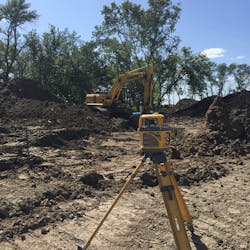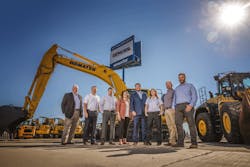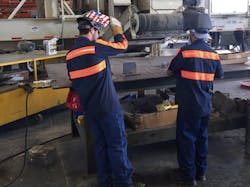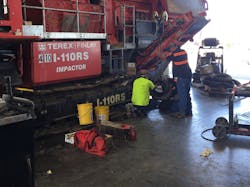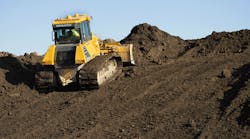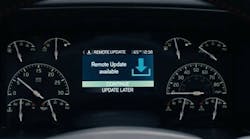GES is Construction Equipment’s 2019 Dealer Excellence Award winner. The award recognizes those who are leveraging technologies to ensure fleet managers have equipment at the right cost and the right time to do their jobs efficiently and effectively. Construction Equipment used its 6 Pillars for Partnership to evaluate the dealership: technicians, service infrastructure, manufacturer relations, technology infrastructure, data management, and service management. Click here for 2020 nominations.
Integrated technology—specifically machine data and machine control—enable GES to enter squarely into a fleet’s workflow, offering services that support equipment operations. Komatsu is GES’s primary heavy-equipment line, and it complements that with Kobelco excavators at certain branches, JCB for light equipment and telehandlers, Link Belt cranes, and several brands of aggregate equipment such as Terex Finlay and KPI-JCI.
According to Construction Equipment research, about 45 percent of equipment managers rate their primary dealer’s ability to partner on service as “excellent” or “very good.” GES is ready, and Komatsu has been instrumental in enabling the dealership to make the move into fleet partnerships. In addition to Komtrax on the machine data side, Komatsu’s range of intelligent earthmovers spurred GES ownership to create a new position in 2018 focused solely on supporting the machines and customers using that technology: Smart Construction Business Manager.
“We saw [Komatsu’s integrated GPS modeling] as a real advantage over our competitors,” Stafki says. “Coupled with that, it gives our customers advantages over their competitors.”
GES hired Mitch Strehlow to fill the new position, plus two others as what Komatsu calls Technology Solutions Experts, who report to Strehlow.
“The main focus of my job is the technology and GPS,” Strehlow says, “but while I’m on site, I’m watching how the workflow of their job site is going. It may be identifying a bottleneck, or their job’s taking too much time, or maybe there’s a safer way to do something. I’m able to watch, talk to them, and [see] how we can help them. That’s the goal.”
These conversations often center on cost in the beginning, as the technology investment is not small, Strehlow says. He explains how machine control will save money and improve production. He explains the efficiencies of accurate earthmoving, and how machine control gives experienced operators a tool to make them better. It also elevates the younger ones, he says.
“[The older guys] are more experienced, they can feel what they’re on and can understand how the dozer’s reacting,” Strehlow says. “Beginning operators don’t have the time to grasp that concept in their first year of operating. If you throw the GPS in there, you make them a better operator, you make them more efficient right away. They are the ones who are really really embracing the technology.”
Once the customer invests in machine control, conversations turn to project management. GES will facilitate building the models for machine control, working with a third party, then will help the contractor upload the files into the machines.
“We’re just trying to be that one-stop shop for the customer,” Strehlow says. “They’re already coming to us for parts, for service, for sales. Why not for one more portion? Instead of going to this guy for my machine, this guy for my machine control, this guy for my modeling; we want to be the one-stop shop.”
Strehlow also supports sites that use machine control from other vendors. Although Topcon is preferred because it’s the Komatsu provider, Strehlow can help customers who are running a Trimble site.
“If we’re going to run a Komatsu machine or a Topcon machine on a Trimble job site, we also have to convert their files,” he says. “I’ll pull everything into Trimble business center, I’ll export it in a different format, then I’ll import it into Topcon’s. I export it as a TP31 single file that our machine runs off of.”
Strehlow regularly visits customer projects. Even though files can be loaded and updated remotely, he says that hands-on interaction builds the trust needed for partnership.
Machine data and the service support it enables allows GES to partner in another dimension of a fleet’s workflow: utilization and availability. Komatsu machines, of course, come loaded with Komtrax. But all GES’s brands have telematics, Stafki says. The dealership utilizes the ISO telematics standard in order to manage machine data.
“We have one guy [who] manages that data,” he says. “Our beginning stage is really focusing on the day-to-day aspect with our customers. We’re not focusing on the 19 [data points in the standard], we’re looking at the data points that are important to the customer.
“Customers hate trying to remember to change the oil,” he says as an example. “They just want to go; they don’t want to worry about changing the oil. Plus, labor is in short supply, so they don’t have the people to fill the seats, operate the machines, and change the oil and do all the proper maintenance on those machines. We want to fill that void; we want to be there to help them so when they get in the seats, they’re ready to go.”
Each machine GES sells is assigned to a branch, and each customer’s service rep, as well as the service manager, respond according to the urgency of an alert. The service rep communicates the service need to the customer and works with them to schedule. In some instances, the customer may do the work itself, asking simply that GES deliver the necessary parts. Other times, the customer schedules the work with the dealership.
“There’s so much data that is available,” Stafki says. “Being able to use that data correctly is a challenge.
“If you try to shove this down a customer’s throat, it just goes nowhere. Finding the right data for the customer is just as critical as the data itself. Once again, it comes back to the tried and true: building those relationships so that you can understand what they’re needing before you can try something you think they want.”
Stafki says 85 percent of the rolling stock (GES’s term for mobile equipment such as excavators, loaders, and telehandlers) it supports transmits machine data to the dealership. In some cases, a third-party telematics system is installed. Machine monitoring across brands allows GES to ramp up its service agreements. About 60 percent of the Komatsu machines GES sells remain on a service contract after the initial free 2,000 hours provided by the manufacturer, he says.
“What our customers do best is build. What we do best is take care of their machines,” Stafki says. “If the customer knows their machine is going to be taken care of—and it’s done correctly, without worries, and at a fair price—that’s taking one thing off their plate that they don’t have to worry about anymore. If you can make the customer’s life so easy by this equipment and support, they’re not going to want to choose other brands.
“I want to wow that customer, so they think, ‘Next time, we want to own Komatsu.’”
Eventually, Stafki says, data will allow GES to offer machine-management services that help the customer manage fleet age and replacement plans.
“We can show them, based upon history, ‘here is where your cost is going to spike,’” he says. “‘Right here at 9,200 hours. This is the spot.’
“The challenge is building the trust with the customer so they can see the value of that. We hope that they will use some of that data, but I think we’re still five or six years away from really stepping into that market.”
In the meantime, Stafki says the dealership is solidifying its service infrastructure, specifically its shop facilities and computer systems. On the backend, GES has three full-time information technology support people, and two others who work solely on the programming side of the business—everything from the software that’s required to plug into machines to the software required for running the business, he says.
GES operates eight branches in North Dakota, South Dakota, Minnesota, and Iowa, and two branches in Canada. Part of the dealership’s business planning is shop investment, Stafki says, including the construction of a new parts warehouse, which will be completed mid-2020.
“It’s a constant state of improvement because the machines are changing so much,” Stafki says. “Also, [it’s] a younger workforce, so we have [added] little offices right on the floor to be able to facilitate easier communication between [supervisors] and the techs. We are putting tooling in the correct places, updating lighting, updating concrete. [It’s about having] the right safety equipment, the right lifting equipment.
“As a company, we have a huge investment here, because if you don’t have the infrastructure behind everything, all of it is for naught.”
GES has also invested heavily in workforce development, creating a position specifically tasked with not only recruiting, but also retaining quality employees. Five years ago, GES hired Ann Pollert as its director of workforce development.
Part of her work revolves around a program Komatsu America has with North Dakota State College of Science (NDSCS) called the Komatsu Partnership Program. NDSCS offers a two-year diesel technician track, resulting in an Associate’s degree, but students’ exposure to heavy equipment was limited, Pollert says. The Komatsu program focuses on heavy construction equipment, and it is available to any Komatsu dealer.
The two-year program includes internships and job shadowing, including a stint the summer before starting school. Schooling consists of classroom and lab study at NDSCS, supplemented with three paid, eight-week internship experiences in one of GES’s shops. The first seven months of their first year at NDSCS, students learn the same basic material as general diesel technicians, regardless of brand. “After that, everything they see is Komatsu,” Pollert says.
“Our relationship starts [that first] summer, and it continues the entire time they’re in school,” she says. “So, when they graduate, they’re guaranteed a job.”
GES reimburses 70 to 100 percent of tuition and fees, based on grades, over a three-year period while they work for the dealership. Pollert emphasizes that it’s not about hiring technicians, but about providing career opportunities within GES for young people. As technicians are promoted to supervisors, for example, graduates from the program can be ready to advance. Her additional role of retention kicks in.
It’s a tough coupling, pairing the human side of customer service to the technology necessary for data-driven machine management. But GES management recognizes that future as a win for itself and for the fleets it services, so the commitment continues toward a partnership that could possibly change the way an equipment manager does their job. Stafki uses a truck dealership to sum up where GES is heading.
“They base their business model off of the sweet spot,” he says. “They will take your data and pinpoint when you need to trade in all your trucks. They’ll handle the financing, the purchasing, and another truck just shows up.
“That is what the equipment industry will be eventually.”
